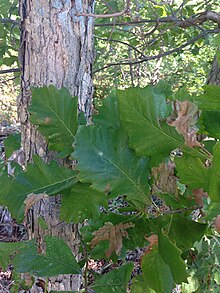| Quercus × deamii | |
|---|---|

| |
|
Scientific classification
| |
| Kingdom: | Plantae |
| Clade: | Tracheophytes |
| Clade: | Angiosperms |
| Clade: | Eudicots |
| Clade: | Rosids |
| Order: | Fagales |
| Family: | Fagaceae |
| Genus: | Quercus |
| Species: | Q. × deamii
|
| Binomial name | |
| Quercus × deamii | |
| Synonyms [2] | |
|
Quercus × fallax E.J.Palmer | |
Quercus × deamii (or Quercus deamii), known as Deam's oak, is a naturally occurring hybrid of chinquapin oak ( Quercus muehlenbergii) and burr oak ( Quercus macrocarpa). It occurs sporadically where their ranges overlap in the eastern United States and eastern Canada. [2] It is named for self-taught botanist and state forester of Indiana Charles C. Deam, who had forwarded samples to William Trelease for description. They thought it to be a cross of Quercus alba and Q. muehlenbergii due to the large numbers of those trees growing in the vicinity. [3] Many sources still reference Q. × deamii as a hybrid of the white oak and chinkapin oak.
Quercus × deamii is a forest tree with pale bark and a spreading crown of stout branches. The twigs and leaf undersides are short-hairy. [4]
When the original tree was marked for felling, Deam managed to buy the 0.2 acres (0.08 ha) of land it stood on for the state. It is now the Deam Oak Monument Forest, at 40°46′42.4″N 85°11′35.3″W / 40.778444°N 85.193139°W, with the tree still alive as of May 2020 [update]. [3] [5] A cultivar, 'Champion Seedless', with the ortet being the Deam oak, is available from specialty nurseries. As the name suggests, it does not produce acorns, a desirable trait in certain garden and landscaping applications. [6]
References
- ^ Proc. Amer. Philos. Soc. 56: 49 (1917)
- ^ a b "Quercus × deamii Trel". Plants of the World Online. Board of Trustees of the Royal Botanic Gardens, Kew. 2017. Archived from the original on 20 October 2020. Retrieved 20 October 2020.
- ^ a b Hibben, George (2012). "Charlie Deam and the Deam Oak (Quercus x deamii)" (PDF). Arnoldia. 67 (4): 15–24. Archived (PDF) from the original on 22 October 2020. Retrieved 20 October 2020.
- ^ Wilhelm, Gerould; Rericha, Laura (2017). Flora of the Chicago Region: A Floristic and Ecological Synthesis. Indiana Academy of Sciences.
- ^ Bell, Bruce (3 May 2020). "Deam Oak Monument Forest". theclio. Clio: Your Guide to History. Archived from the original on 23 September 2020. Retrieved 20 October 2020.
- ^ Branhagen, Alan (16 November 2016). Native Plants of the Midwest: A Comprehensive Guide to the Best 500 Species for the Garden. Portland, Oregon: Timber Press. p. 115. ISBN 9781604697773.
| Quercus × deamii | |
|---|---|

| |
|
Scientific classification
| |
| Kingdom: | Plantae |
| Clade: | Tracheophytes |
| Clade: | Angiosperms |
| Clade: | Eudicots |
| Clade: | Rosids |
| Order: | Fagales |
| Family: | Fagaceae |
| Genus: | Quercus |
| Species: | Q. × deamii
|
| Binomial name | |
| Quercus × deamii | |
| Synonyms [2] | |
|
Quercus × fallax E.J.Palmer | |
Quercus × deamii (or Quercus deamii), known as Deam's oak, is a naturally occurring hybrid of chinquapin oak ( Quercus muehlenbergii) and burr oak ( Quercus macrocarpa). It occurs sporadically where their ranges overlap in the eastern United States and eastern Canada. [2] It is named for self-taught botanist and state forester of Indiana Charles C. Deam, who had forwarded samples to William Trelease for description. They thought it to be a cross of Quercus alba and Q. muehlenbergii due to the large numbers of those trees growing in the vicinity. [3] Many sources still reference Q. × deamii as a hybrid of the white oak and chinkapin oak.
Quercus × deamii is a forest tree with pale bark and a spreading crown of stout branches. The twigs and leaf undersides are short-hairy. [4]
When the original tree was marked for felling, Deam managed to buy the 0.2 acres (0.08 ha) of land it stood on for the state. It is now the Deam Oak Monument Forest, at 40°46′42.4″N 85°11′35.3″W / 40.778444°N 85.193139°W, with the tree still alive as of May 2020 [update]. [3] [5] A cultivar, 'Champion Seedless', with the ortet being the Deam oak, is available from specialty nurseries. As the name suggests, it does not produce acorns, a desirable trait in certain garden and landscaping applications. [6]
References
- ^ Proc. Amer. Philos. Soc. 56: 49 (1917)
- ^ a b "Quercus × deamii Trel". Plants of the World Online. Board of Trustees of the Royal Botanic Gardens, Kew. 2017. Archived from the original on 20 October 2020. Retrieved 20 October 2020.
- ^ a b Hibben, George (2012). "Charlie Deam and the Deam Oak (Quercus x deamii)" (PDF). Arnoldia. 67 (4): 15–24. Archived (PDF) from the original on 22 October 2020. Retrieved 20 October 2020.
- ^ Wilhelm, Gerould; Rericha, Laura (2017). Flora of the Chicago Region: A Floristic and Ecological Synthesis. Indiana Academy of Sciences.
- ^ Bell, Bruce (3 May 2020). "Deam Oak Monument Forest". theclio. Clio: Your Guide to History. Archived from the original on 23 September 2020. Retrieved 20 October 2020.
- ^ Branhagen, Alan (16 November 2016). Native Plants of the Midwest: A Comprehensive Guide to the Best 500 Species for the Garden. Portland, Oregon: Timber Press. p. 115. ISBN 9781604697773.